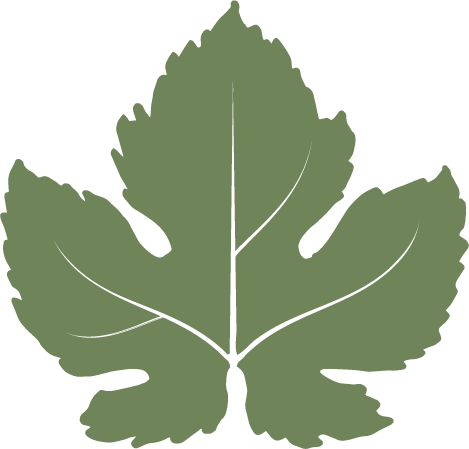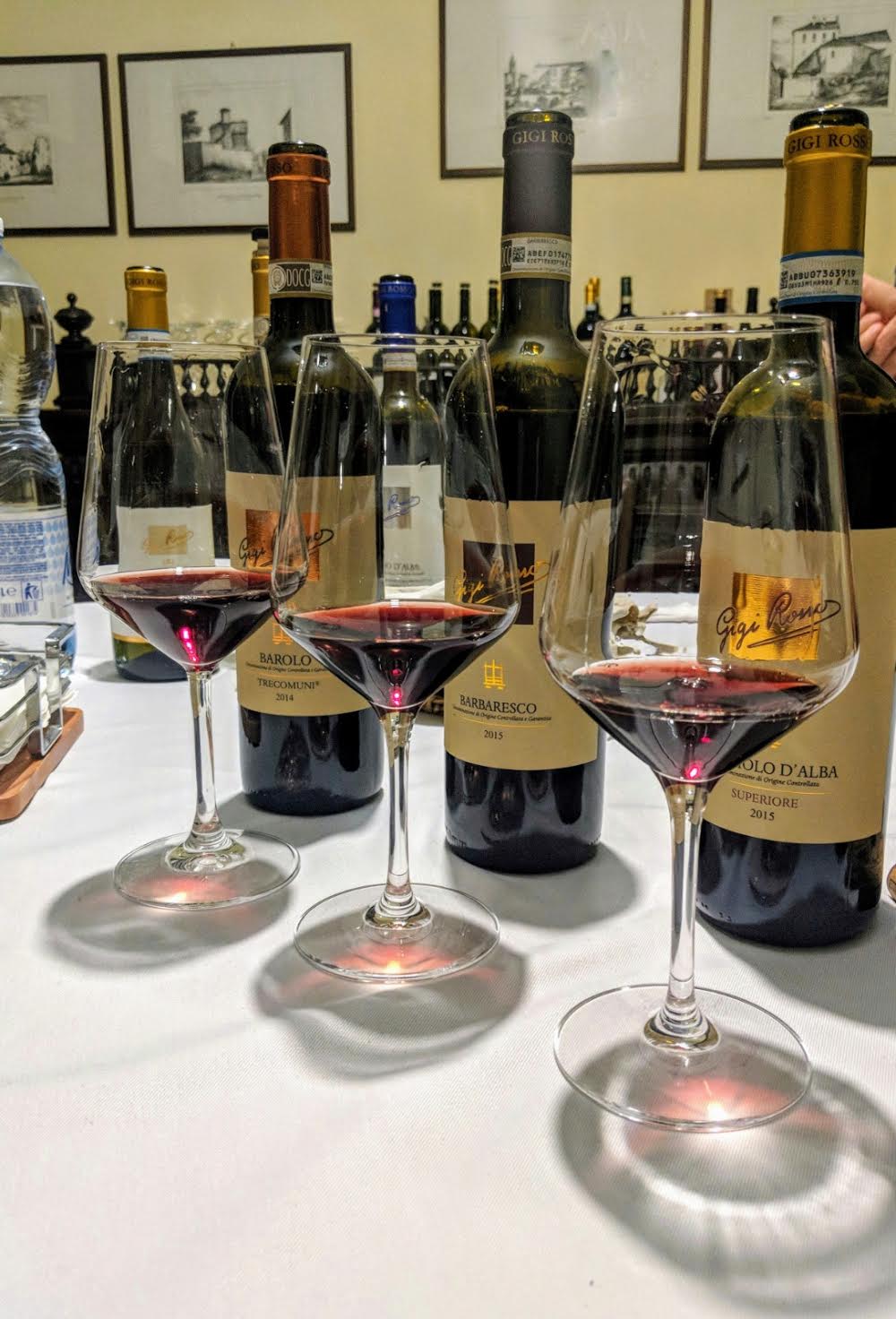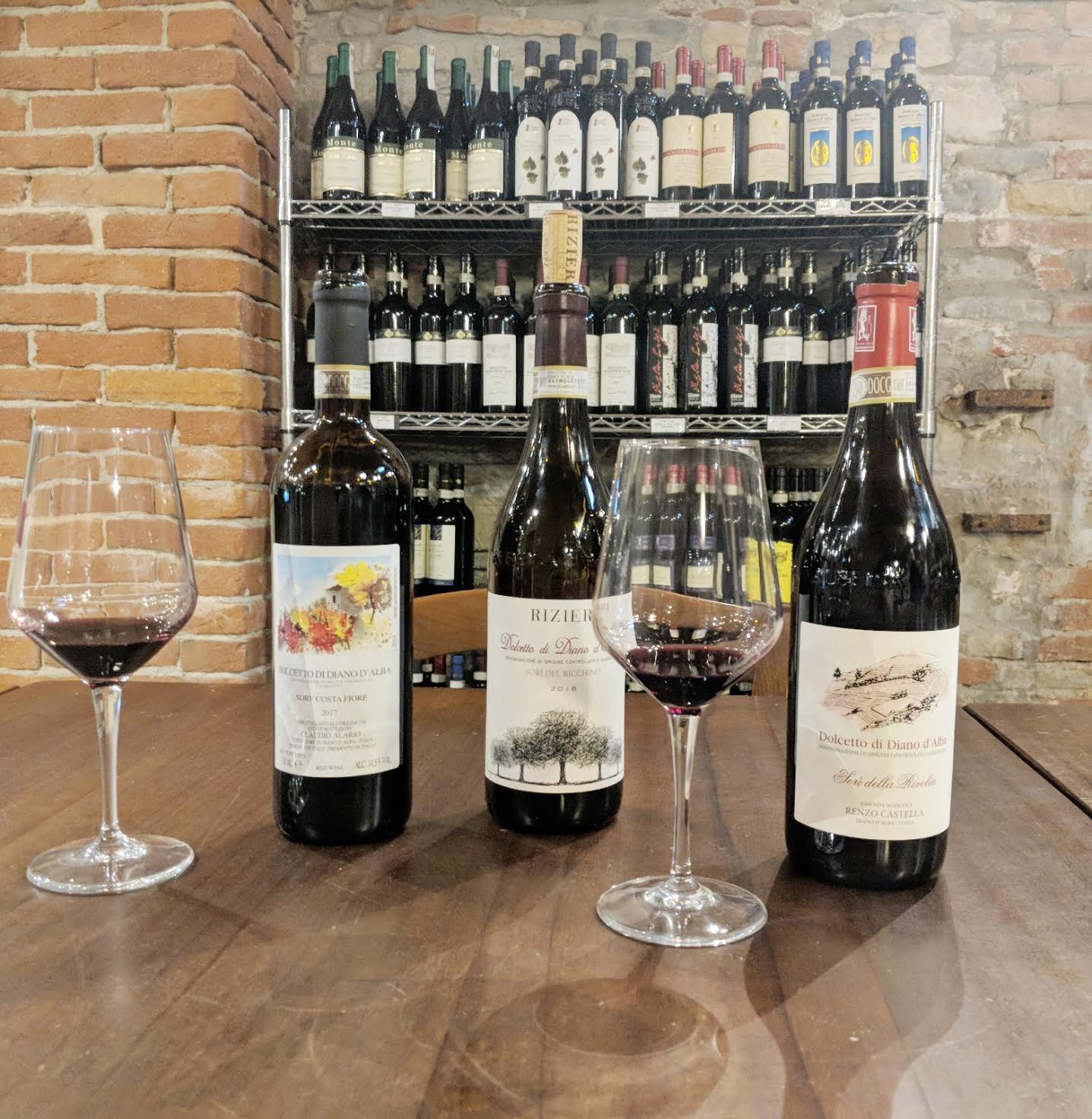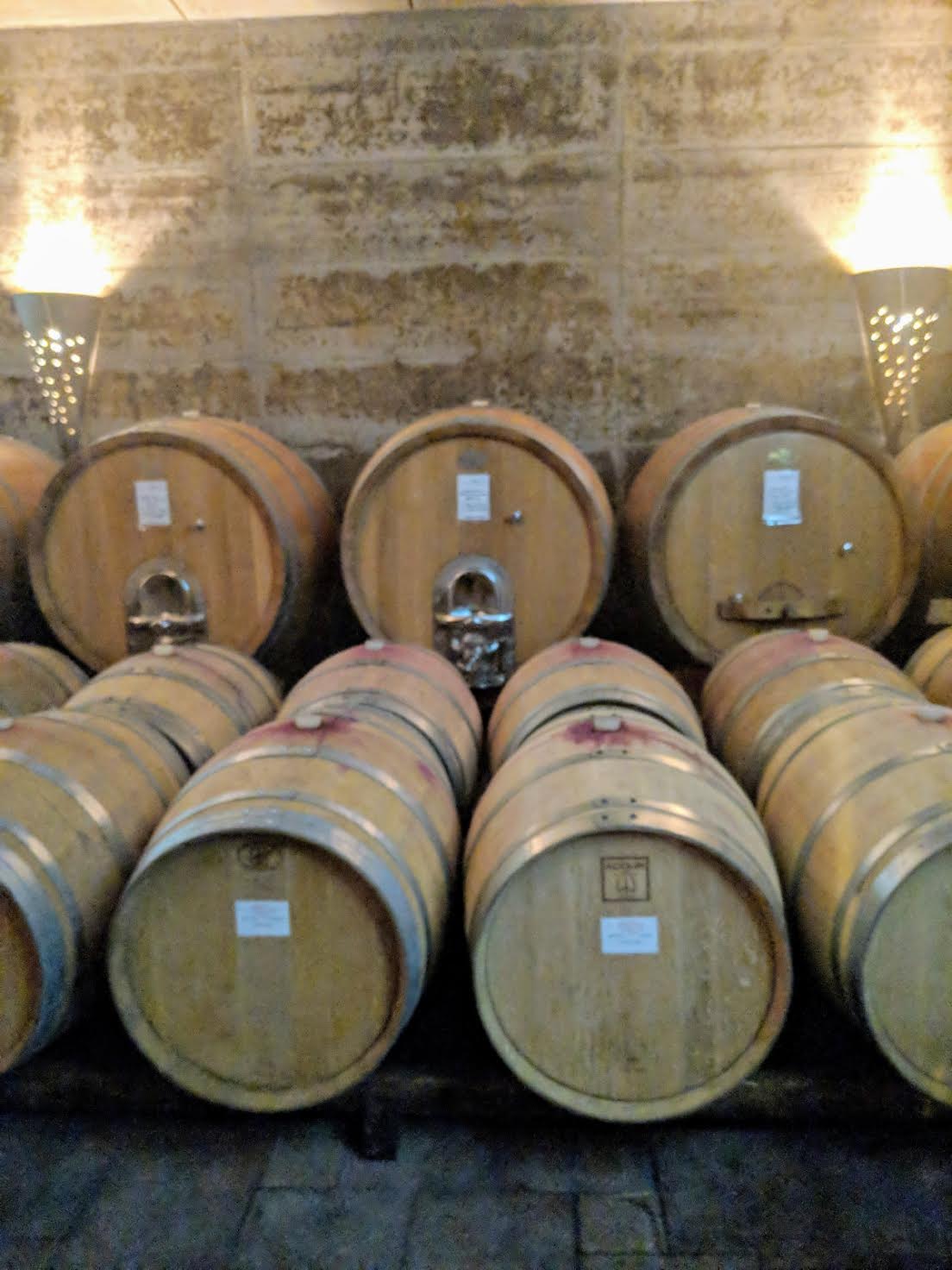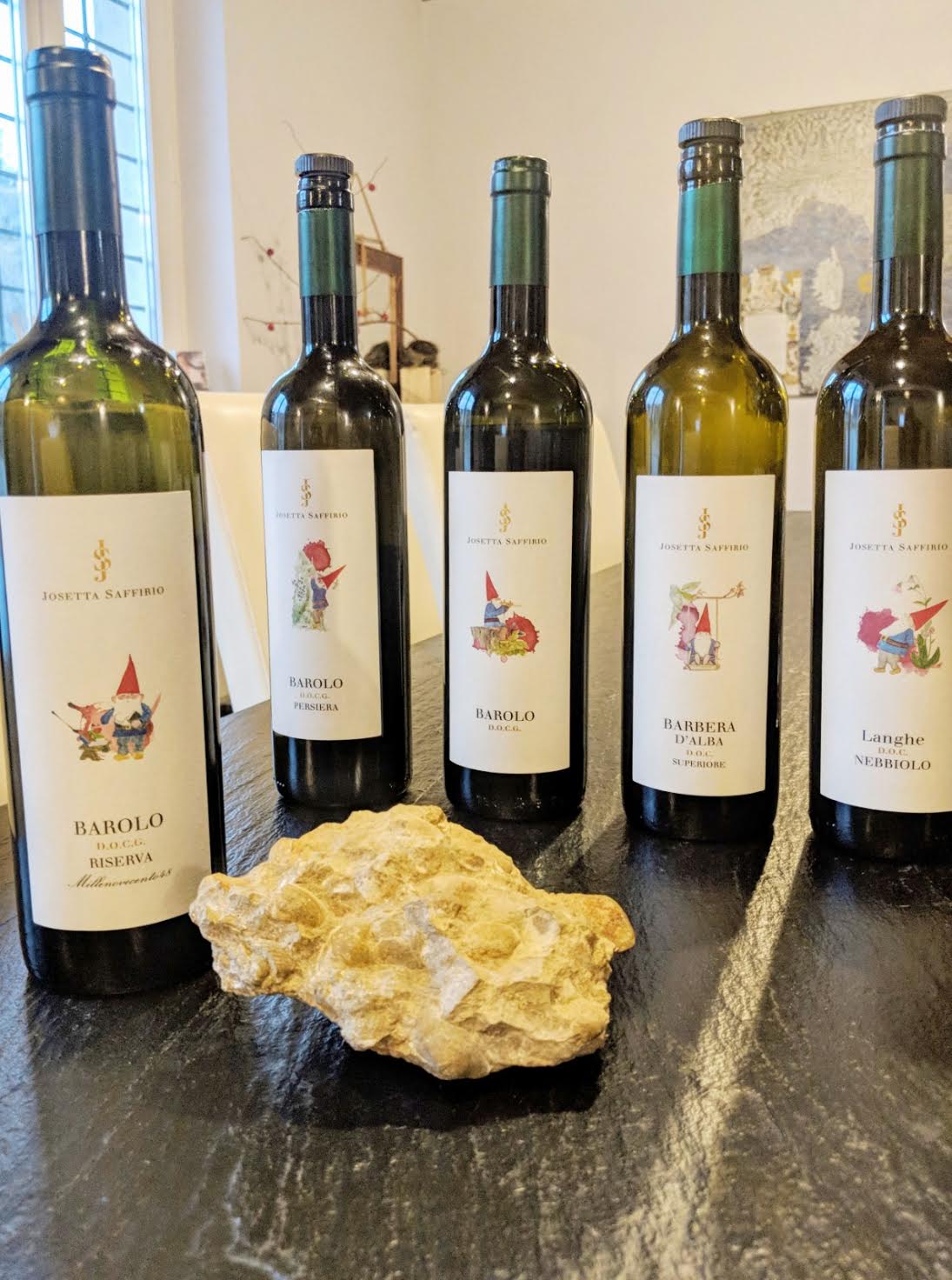Pieces of Piedmont
From the rolling hills and morning fog to the unique cuisine, beautiful architecture and incomparable wine, my trip to Piedmont was nothing short of spectacular. You won’t find pizza in Piedmont, in fact the diverse cuisine is heavily influenced by neighboring France, with meat and cheese at the focus. Another similarity to France was the local dialect, a language still spoken that’s genetically closer to French. Piedmont is known for the production of Nutella, Arborio rice, Fiat cars, the Borsalino hat, and of course, as one of the most famous wine regions of the world.
Similar to many of the greatest wine-producing regions, much of Piedmont’s vineyards were once under the sea. Many of the wineries I visited even displayed some artifacts found in their vineyards, such as seashells and crustaceans. Today, the geologically diverse soil is comprised mainly of alluvial, clay, sand and marl. The hillsides can be quite steep throughout Piedmont, making it necessary to work many of the vineyards by hand. The top three wine producing areas of Piedmont are Monferrato, Roero, and Langhe. Fortunately, I was able to visit all of them, in that order.
Monferatto
Where I stayed: Tenuta Montemagno Relais & Wines
This stunning and secluded hilltop resort also has winery at the property from the same name. Surrounded by vineyards and an infinity pool, I highly recommend this relaxing estate when in Piedmont. I met with Director Marco Fasoli, who manages the winery and hospitality program. Marco gained most of his experience as the Director of Business for world-renowned estate Marchesi Antinori. In addition, Marco works with the restaurant on creating innovative cuisine, as he’s also an instructor at the ICIF (Italian Culinary Institute for Foreigners).
The Montemagno Winery is certified organic and produces approximately 180,000 bottles per year. They have been exporting to the USA and Europe for approximately 5 years. Marco led the tasting with several whites, reds, and sparkling wines. Among my favorites was the 2016 Solis Vis, a high acid white wine from the Timorasso grape. Marco explained that Timorasso is harvested after the red wines, and requires extreme ripeness on the vine. It also performs best when planted on clay soil, which offers more of a full structure than the red clay, planted to Barbera and Grignolino. The mineral-driven Solis Vis had notes of ripe melon and seashells.
Perhaps the most interesting tasted were the two sparkling wines from Barbera. Both produced in the traditional method and hand-riddled still today, their names “24” and “36” signify the time they spent on the lees. The “36” was especially aromatic with orange peel, mint and red berries on the nose. Among the still wines from Barbera, the 2015 Barbera Mysterium was full of black fruit, menthol, and incense. This full-bodied wine comes from their oldest vines, which are approximately 90 years old. Marco enlightened me with his views on Barbera, explaining that it’s “kind of an ignorant grape, and actually requires good winemaking, unlike other varietals. It definitely needs oak for structure.” The winery also produces a fantastic Barolo from La Morra in the Langhe. Legally, the wine must be fermented and produced there, to be labelled as Barolo. The aging process can be completed at the estate, however.
Montemagno focuses on lowering sulfites in any way possible. This is achieved using traditional methods and innovative technology. For example, the red wines are neither punched down nor pumped over. Instead, Montemagno is utilizing Nectar technology, which involves a delicate second fermentation by temperature control. The white wines undergo a soft pressing and carbonic maceration with dry ice, to preserve delicate aromas.
Roero
Where I stayed: Villa Tiboldi
Owned by Malvira winery, and ran by the winemaker’s wives, this beautifully designed hotel dates back to 1750. Owner and winemaker Roberto Damonte led me through the stunning hotel, pointing out each of the insanely steep vineyards surrounding the property. Complete with a beautiful restaurant, tasting room and swimming pool, this historic hotel is an absolute must. My pink suite (below) had antique furniture and a newly remodeled bath. It was the perfect balance between old and new.
Roberto led me through Malivra winery and cellar before we started the tasting. His father started the winery in the 1950s and he and his brother took it over in 1973. The estate has been certified organic since 2017. They’re producing around 300,000 bottles annually from just over 100 acres, of which about half is white wine.
Roberto is focused on showcasing how red and white wines from the Roero can age. 70 years ago, Roero reds were meant for drinking quite young. This was also when there were no middle men, and the wine was going straight to the consumer. They realized the importance of producing high quality wines that could be enjoyed over the course of several years, all over the world. He recognized that oak aging is necessary for Barbera, especially for long-term satisfaction. However, the percentage of small, large, old and new barrels varies each year. His goal is to remain consistent in terms of flavor, keeping the consumer unable to recognize much of a difference from vintage to vintage. This can be difficult to achieve with weather fluctuations, as you can probably imagine. For example, the 2018 vintage will have a slightly lower production since there was a bit more rain than last year.
Roberto explains that white wine has a reputation of being drank quite young, but that is not the case for his Arneis today. As we began the tasting, I couldn’t agree more. Malvira is especially known for their Arneis, though relatively new for the region of Roero as a whole. 40 years ago, over 95% of Roero was planted to red grapes and today it’s closer to 50%. The grape is intensely aromatic and complex, which is likely the reason behind its recent popularity. Malvira’s 2014 Roero Arneis Vigna Renesio had me most intrigued, with vibrant citrus aromas, high acidity and impressive minerality. This comes from the most historic vineyard for Arneis, where the first record of the grape was found in 1478. At 3 years old, this wine is perfectly ready to drink, with lively evidence of calcareous soil. The 2015 Roero Arneis Vigna Salietto was partially aged in oak (about 50% of the total wine), but not apparent to me, the wine simply showed more ripe fruits like melon and lime. Among the red wines, the 2016 San Michelle Barbera stood out with vivacious plums and berries, followed by poinsettia and pine. This is my idea of the ultimate holiday wine.
We had dinner at the fabulous Enoteca Regionale del Roero (one Michelin Star), where I tasted Tajarin for the first time. This egg-based pasta is like a rich linguine from heaven. Commonly served with beef ragout, ours came with shaved white truffles.
Langhe
I visited Cantina Comunale “I Sori,” an Association that focuses on Dolcetto from Diano D’Alba. This tasting room is in the heart of Diano d’Alba and had dozens of producers that specialize in not only Dolcetto but Barbera and Nebbiolo as well. Two DOCGs exist for Dolcetto, Diano d’Alba and Dogliani. Many agree that the Dolcetto from Diano is more elegant than Dogliani, which can be quite full bodied and masculine. While often rough in tannin, Dogliani is known to age longer. Diano d’Alba is best enjoyed while only a few years old. Many producers in this area have winemaking habits that last for generations. While the innovation is there, the recipe stays the same. 40 years ago, you could actually make Barolo from Diano d’Alba but back then, Dolcetto was more popular.
Dolcetto is a difficult grape to harvest, especially in bad weather. It’s a small berry with thin skins and it’s quite easy to break if you aren’t careful. We tasted ten wines by “Sori” or vineyard site, which is similar to France’s cru system. The 2017 Claudio Alario’s “Sori Costa Fiore” was one of the most complex, in my opinion, with notes of strawberries, Asian spices and herbs. He also produces a wine from the Pradurent Sori that he ages in new oak, something relatively unique for the varietal. It wasn’t my personal favorite but resembled Barolo a bit for that reason. The 2017 Renzo Castella Sori della Rivolia also opened up beautifully, but it will clearly need another 5 months or so to even itself out as the tannins were quite tight.
Josetta Saffirio was the next winery visited, and one that I had personal experience selling and pouring over the past 7 years. Located in Monforte d’Alba the family has five generations and over 200 years of experience in viticulture and vinification. The small team of just five people employ ten more through a co-operative during harvest. Their five and a half hectares are farmed organically, and over 70% of their production is Nebbiolo. The winery focuses on sustainability and social responsibility, and even insulated the perimeter with natural cork to reduce heat. They care for the environment throughout the entire wine making process.
The tasting began with a sparkling Nebbiolo rosé, which was the first I’d ever tried. The wine spent 6 hours on the skins to impart a stunning, rose gold color. With just 5 grams of sugar per liter, it is considered Brut. This is Josetta Saffirio’s only sparkling wine and they produce about 5,000 bottles of it per year. They are one of the only estates in Piedmont (and the world) producing a sparkling style of Nebbiolo. The nose was a bit restrained but the palate revealed stunning complexity, especially floral and herbaceous notes. The light body and high acidity kept this wine very refreshing, making it quite easy to enjoy more than one glass.
We moved on to the reds, starting with the Langhe Nebbiolo and ultimately three vintages of Barolo, 2012, 2013 and 2014. We discussed the 2014 vintage which didn’t have the highest reputation at the start. Now, Piedmont’s best winemakers are noticing it’s potential and Barolo from 2014 is being described as multifaceted, with tertiary, complex aromas. I picked up notes of orange blossom, chive, pumpkin and earth-driven granite. While 2014 Barolo may not age like the warm and fruit-forward 2015 vintage, at least we won’t have to wait to drink them!
2013 was a much warmer vintage for the estate, and their Barolo from this year has 15% alcohol, compared to most others at 14.5%. It was rich and had a raisonated fruit quality. The 2013 Barolo Persiera vineyard had notes of licorice and raspberry jam, along with a full body and high tannins. Clearly, this wine is built to age. The 2012 Barolo Riserva was herbal and complex with notes of balsamic, rosemary and white flowers. While perfectly ready now, this wine has a long life ahead.
Gigi Rosso was the next winery visited, in Castiglione Falletto, the heart of the Barolo area. Today, the estate is ran by Maurizio Rosso, Gigi’s son. Maurizio has decades of experience in winemaking and he’s also the author of “the Mystique of Barolo,” a personal chronicle of his life-long love affair with Barolo and the Nebbiolo grape. Maurizio led me through the winery with his son Andreas, an integral part of their operation. The family has a rigorous respect for local winemaking, and even have a collection of antique winemaking tools in their cellar! Perhaps the most fascinating part of the cellar, however, were the botti (huge barrels), which were the largest I had ever seen. Andreas explained that they’re eight centimeters thick and currently about 45 years old. With proper scraping, they should last another 20 years. As you might imagine, these old and extremely large botti rarely convey oak characteristics in the wine, which is precisely why Gigi Rosso utilizes them.
Gigi Rosso has a total production of 100,000 bottles and 65% is exported. The estate makes a wide range of wines, and owns vineyards all over Piedmont. For instance, they make 2,500 bottles of Arneis from a newly acquired vineyard in Roero. They estimate a full crop of 4,000 bottles next year. The winery is also making barrique-aged Chardonnay. This Burgundian style is fermented 6 months sur lie and comes from one of the highest vineyards in Diano d’Alba. The high elevation and eastern exposure compliment the chalky soil for production of Chardonnay in this area. Due to climate change, other growers nearby have been replanting with Chardonnay (and even Viognier) vines as well.
Moving on to the red wines, Gigi Rosso’s Diano d’Alba Sori del Moncolombetto (Dolcetto) was very complex, with soft tannins and a nose full of cherries, blossoms and tobacco. Maurizio prefers not to label the wine as Dolcetto, however since some people (mainly Italian) tend to mistake it as “dolce,” meaning sweet. This wine is most definitely not sweet, but rather a zippy and easy-drinking dry style. The 2015 Nebbiolo Superiore spends 18 months in barrel, which is 6 months longer than necessary for including “Superiore” on the label. The light garnet color followed with surprisingly high tannins and acidity to match. The 2015 Barbaresco was quite approachable with soft tannins. The flavors were elegant, with dried herbs and spices on the nose. The 2014 Barolo is a blend of three of Gigi Rosso’s vineyards. The long finish was astounding and notes of ripe cherry, strawberry, roses and dried basil continued to arise after the several times I returned to it.
Where I stayed: Gigi’s Guest House
I was fortunate enough to stay at Maurizio’s guest house, just 5 minutes from the winery. The two bed/two bath was much more than enough room for me, and it would be perfect for a family or two couples. Waking up to panorama vineyard views in the heart of the Barolo area was such a treat. I highly recommend booking his beautiful home, if available!
My last day began at Cascina Castlet in Castiglione, operated by the renowned Maria Borio. Maria has inherited 31 hectares of vineyards in Costigliole d’Asti from her family since 1970. She is notorious throughout Italy and truly an outstanding winemaker and businesswoman. She offered an abundance of history while leading me through the winery and tasting.
Over half of the estate’s production is Barbera, followed by Moscato, Chardonnay, Uvalino, Cabernet and Nebbiolo. Cascina Castlet makes a few different styles of Barbera. The first is a rather simple, “Nouveau” style that’s meant to enjoy each year before Christmas. There’s still a bit of CO2 and residual sugar in this wine. The label is an image of Maria and her cousins riding a Vespa from the 1940s. The Vespa was an icon at the time, as it was the first affordable mode of transportation. It symbolizes a sense of freedom or rebirth. At that time, Barbera was rather low in terms of quality, but Maria’s family began to believe in the grape. They realized that Barbera could age for decades and that the possibilities were endless. Similar to the Vespa, this simple wine is affordable and showcases the history of this region.
The second Barbera is meant to enjoy before Easter. When producing this style, the winery doesn’t use heat in the cellars, rather they wait for the Spring temperatures to do the work. There is no residual sugar left in this wine and it’s aged in cement tanks before being transferred to stainless steel. Lastly, the third style of Barbera is called “Litina,” and is the best production from the prior (second style) that the winemaking team puts into oak for six months to one year. This is easy to sell and enjoy for years and historically provided the family with a constant cash flow. It is low in tannin with a round body, and Maria explained that the fruit is still this intense after 10 years, which is when the tertiary aromas start to reveal themselves. Since this region of Monferatto doesn’t have Barolo or Barberesco, Barbera is their prize. For this reason, “Litina” has the flagship logo of the company on the label. This wine had notes of morello cherry, ripe plums, oregano and mushroom. Litina is the nickname of Margherita, Maria’s aunt who passed on some Barbera vineyards to her.
We proceeded to taste some very unique wines, such as the “Passum,” a Barbera produced in an appasimento style. This tasted like Amarone but more fresh and easier to drink. Today, the grapes raisonate on racks for one month, in a controlled air ventilation room immediately after harvest. Then, 20% of grape must is added before aging in a mix of botti and tonneaux. Next was the “Policalpo,” a field blend of Cabernet Sauvignon and Barbera vinified together before aging one year in barrique. This full-bodied style is meant for exporting and sort of their version of a Super Tuscan.
Finally, we tasted the notorious “Uceline,” produced from the almost-extinct varietal Uvalino. After finding a few of these unknown vines dispersed across their vineyards, Cascina Castlet proceeded to do some intense research and DNA studies. Many believed that this forgotten grape was extinct, and Cascina Castlet has the only two hectares in the world! They are currently making 5,000 bottles of this wine per year, and the yields are similar to those at Chateau d’Yquem. “Uceline” is always made in a sweet style because it’s resistant to mold. The name, “Uceline” translates to “birds,” because they keep some clusters on the vines as long as possible to attract the birds. These crucial birds eat unwanted insects before harvest and feed off the sugar in the Uvalino grapes. They produce the wine by letting the grapes dry, in an appasimento style. Since it can age indefinitely, they release it whenever they like. It tasted like a great Amarone, with a lighter body and more acidity. Cascina Castlet also makes a few phenomenal white wines such as Chardonnay and Moscato d’Asti, which I highly recommend tasting.
La Strette winery is situated in Novello, one of Barolo’s 11 villages, among Piedmont’s most renowned producers. There are only ten wineries in Novello and the name “La Strette” translates to “narrow road,” which you’d likely notice on your way to the winery, especially back when it was given the name. The estate is 25 years old but the family has a long history of vineyard management. Brothers Mauro and Savio Daniele inherited the winery and vineyards from their parents and specialize in the production of Nebbiolo, Barbera, Dolcetto and Nas-cetta.
In case you weren’t familiar with that last varietal, Nas-cetta is a very rare white grape, indigenous to Novello. In fact, when Le Strette started making it, they were one of just two producers in Piedmont. Today, several estates have followed in their footsteps. It took laborious research and DNA testing for them to figure out what the grape was, however. It was only in 2001 that the grape was registered as a local varietal. In 2003, wineries were able to label their Nas-cetta as Langhe Nebbiolo, DOC. The grape is late to ripen and not too high in acidity, especially for being from Piedmont. The 2017 has distinct minerality and salinity across the palate, along with tropical fruit and exotic flowers. Mauro and Savio own six and a half hectares of this grape and produce approximately 25,000 bottles per year. They also make a single vineyard Nas-cetta from their “Pasinot” vineyard. The vines here are quite new, however after hand-selecting each plant at the University of Turin for their nursery of clones just 3 years ago. 2018 will be the first vintage with these new plants. I tasted the 2017 of both wines, which are skin-contacted, and thus considered orange. I found nectarine, herbs, and tropical flowers on the nose, very complex and aromatic. Savio explained that the grape tends to develop flavors you might find in Sauvignon Blanc, with the tropical aromas turning more citrus over time.
Of the estate’s red wines, Dolcetto ripens first. They only allow one week of skin contact before aging in stainless steel only. La Strette is making about 2,000 bottles each year, as a tradition. Savio described this as “a whole meal type of wine, great with everything from appetizer to entrée.” I considered the 2017 more fruit-driven than others tasted on this trip, with strawberries, black berries and peach candy on the nose. The 2016 Barbera Superiore comes from “Persole,” where 80% of the vines are older than 80 years. At around 400 meters above sea level, the limestone soil gives this wine elevated concentration and structure. It has less tannin than the Dolcetto, but much fuller in weight.
For Barolo, La Strette strives to bottle by single vineyard. They have three in total, and while they vinify separately, some vintages result in the estate blending one or two together. For example, they may not produce much from one vineyard if hail is an issue there that year. Alternatively, they might be showing similar characteristics, which was the case in 2007. Though it was a great vintage, the flavors didn’t vary much, so they ended up blending all three and producing just one Barolo that year. Thus, La Strette can make between one and four different Barolo wines per year.
Their system for aging Barolo was particularly interesting for me. First, La Strette puts the Nebbiolo into small barrels for one year, of which only 15% is new, to impart color. Then, they move it into the larger botti for 15-20 months to develop elegance. I tasted the 2014 Barolo from Bergeisa and Bergera-Pezzole. The Bergera-Pezzole was very balanced and elegant, with classic notes of pepper and tar balancing the fruit. The Bergeisa was ready sooner, Savio mentioned, as the vineyard is higher in elevation, from a mix of soils that result in higher tannin and more spice. I absolutely picked up on the spice with this wine, getting notes of cinnamon and cardamom.
